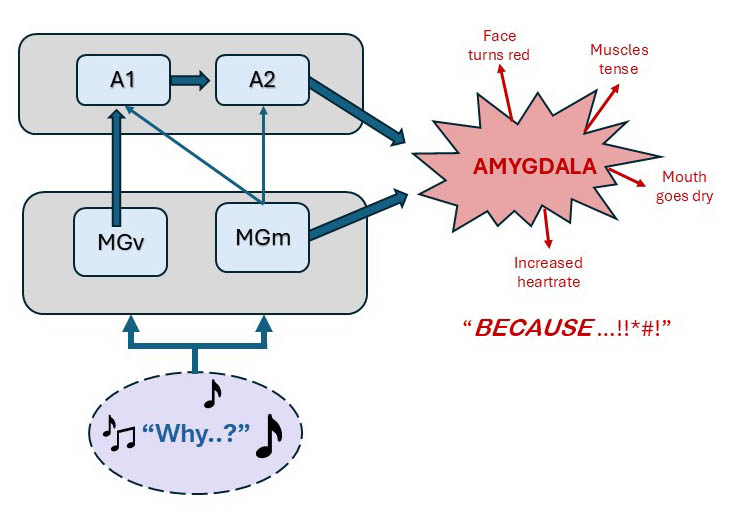Most leaders will nod in agreement with the following quote from Jim Collins’s best-seller, Good to Great.
“When the companies I’ve looked at have operated at their best, they have all had to confront brutal facts. One of the constant, pervasive, and dampening effects of being able to confront brutal facts is that people look for people to blame for things that went wrong. [The great companies] had the ability to do autopsies without assigning blame.“
It sounds great (pun intended) but can be difficult to accomplish. When conducting post-project mortems, safety reviews, or risk assessments, you always have a chance that the foundation of psychological safety required for these discussions will collapse.
How can you minimize the chances of such a collapse? It comes down to your use of the word “why.”
How Do “Why” Questions Affect the Brain?
For over 25 years, I’ve asked my workshop participants from around the globe how they hear the question, “Why did you do that?” Their answers are consistent: That is a statement—not a question! —and it’s telling me that I messed up.
It just so happens that my anecdotal classroom questions have a foundation of scientific support (which applies even to responses in various languages). In an intriguing study of 10,000 utterances across 10 languages, researchers found that questioners use a higher pitch when they begin a tell question (“Why didn’t you first come to me with that issue?”) versus when they pose an information-seeking question (“Whom did you contact regarding this issue?).
When you ask the latter, your pitch remains fairly level throughout your question, but not so with the questions that begin with why. The pitch you use for the initial word is much higher and contains more emphasis than the rest of the words in the sentence. And that higher pitch has an edge keen enough to shred the psychological safety net of the person you’re talking to.
This all happens in a part of your brain called the auditory thalamus, which processes the acoustic information funneling in through your ears. If the pitch is not high, it sends the auditory signal on to the auditory cortex for further processing. Like a high-end sound studio, this area decodes the auditory signals, allowing you to make sense of them, and then you respond—calmly.
But if your auditory thalamus receives threatening information like an unexpected horn blast or footsteps behind you on an unlit sidewalk at night, it switches to a different pathway. In an astonishing act of mental triage, your auditory thalamus signals your amygdala—the center of emotional processing.
Within milliseconds of receiving the auditory thalamus’s signal, the amygdala springs into action, doubling your heart rate, tensing your muscles, locking down your neocortex, and making your palms sweat.
It turns out that this threat-detecting structure is quite sensitive to vocal pitch. When you hear a question such as “Why didn’t you contact them?” the thalamus invokes the second pathway and whisks the signal off to your speedy amygdala. And with lightning speed, your well-intended collaborative dialogue is transformed into a contentious debate.

“What do you mean I should have contacted them?! If we had gone to them, it would have doubled our delivery time!!” you respond. Or you say nothing but are nevertheless disengaged from the dialogue. No more fruitful collaboration.
This is exactly what happened in a meeting a lead engineer described to me that “exploded with the intensity of a nuclear bomb.” The meeting had begun with a sincere desire to conduct a post-project review but ended with people yelling and blaming. The engineer asked me, “What the h—l happened? It just happened so fast,” he observed.
It certainly did. Despite the best intentions, questions asked in the meeting pulled the hair trigger in other’s auditory thalamus, and in less than the blink of an eye, the questions wound up in people’s amygdala rather than the neo-cortex where they meant for it to go.
What To Do Instead
So, how should you handle—or better yet—avoid this?
Studies show that if I ask you by describing the goals or motives behind an action. Conversely, if I ask you a “how” or “how come” question, you will share the preconditions that led to or enabled the action. This means you must consider which of the two categories of information are you hoping to elicit with your question?
If you see an interaction that begins with a why question, focus on the person being questioned. How do they interpret the question? Do their neck muscles tighten? Do they sit back in their chair? Do they respond defensively? Those are all signals that the amygdala might have been tripped.
Whenever I witness these signs, I jump in quickly and ask something along the lines of,
“Woah! Let’s stop a moment here. Andy, when you asked Luisa why she didn’t first come to you, was that a question or a statement? I just want to make sure we have some clarity here.”
If Andy responds with a, “Well, I just think she should have let me know!” I reply with an, “Okay, I can appreciate that. Let’s hear more about your expectations of being informed.”
I do this partly to make sure the questioner is, in fact, asking a question (versus making a statement), partly to move from a generality to more helpful specificity (generalizations are rarely helpful), and mostly to give the person being questioned (in this case, Luisa) a chance to rein her speedy amygdala.
Then I will ask a how question such as, “Luisa, can you share how you went about getting input?” or “How did you conclude that you didn’t need input?”
Conducting post-project reviews, teasing apart the conditions that led to a safety incident, and processing potential risks all require the ability to conduct autopsies without blame. Achieving that level of conversation, however, requires skill at asking questions that support thoughtful exploration and avoiding those that result in a swirling exchange of blame.
NOTES
Atkinson, Brent. “The Emotional Imperative,” Family Therapy Networker 23, no. 4 (1999): 28.
Bartlett, Edward. “The Organization and Physiology of the Auditory Thalamus and Its Role in Processing Acoustic Features Important for Speech Perception,” National Library of Medicine. July 1, 2014
Collins, J. (2001) Good To Great: Why Some Companies Make the Leap…And Others Don’t. New York, NY: HarperBusiness.
John McClure, Denis J. Hilton, Jodie Cowan, Lucyna Ishida, and Marc Wilson, “When People Explain Difficult Actions, Is the Causal Question How or Why?” Journal of Language and Social Psychology 20, no 3 (2001): 341.
M.A. Sicoli, T. Stivers, N.J. Enfield, & S.C Levinson, S. C. Marked Initial Pitch in Questions Signals Marked Communicative Function. Lang. Speech 58, 204–223 (2015).
Ruesch. R. and Bateson, Gregory. Communication: The Social Matrix of Psychiatry (New York: W.W. Norton, 1987).

